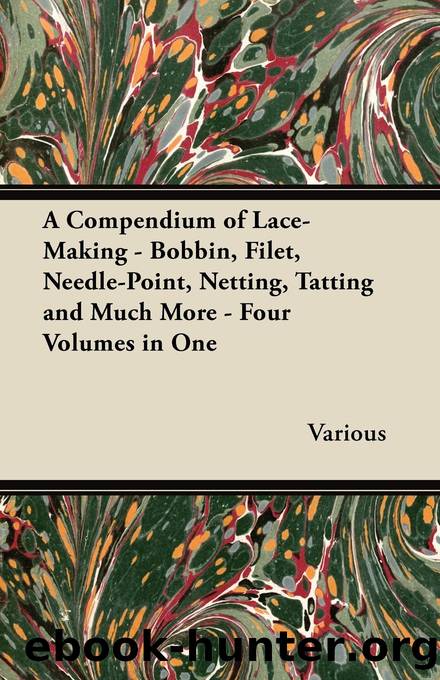A Compendium of Lace-Making by Various

Author:Various
Language: eng
Format: epub
Publisher: Read Books
Published: 2011-06-14T16:00:00+00:00
It is, however, quite easy to make the prickings, and, in the case of a large class, it is a great economy to do so. For this purpose a specially prepared cardboard at 6d. a sheet, 25in. by 19in., is sold, A considerable number of prickings can be made out of one sheet. Each pricking should be about 1 inch longer than the circumference of the pillow. . .
If only a few prickings are needed, the simplest plan is to rule them on the cardboard by measure, as in Plate VII., making dots where the holes should be and afterwards pricking them with a pin. If, however, some number are required, it saves both time and trouble to use Hektograph.
For this purpose the following materials are required:—
1 Tin Hektograph,
1 Baking-tin (at least 12 inches long).
1 Bottle Pumphrey’s Violet Copying Ink.
3 or more Sheets of Cardboard.
3 or more Sheets of Paper ruled in very small squares.
The latter can be bought at the Army and Navy Stores, in the Artists’ Materials Department, at 1 1/2d. per sheet.
Mark out the pattern in dots and faint lines (as in Plate VII.) on a sheet with squares, using the copying ink.
Melt the hektograph jelly and pour it into the baking-tin according to the directions given with it. When the jelly is quite cold, lay the sheet of paper with the pattern on it face downwards on the jelly, pressing it firmly down with a squeejee so that no air can get under; leave it for six minutes and then take it off. Several impressions of the pattern can then be taken off the jelly, thus: Take one of the pieces of cardboard, which should be ready cut up in the right lengths, and press it on the jelly, squeejee it firmly and quickly, and take it off. Do this with as many strips of cardboard as you wish or until the impression becomes too faint.
If the dots are clear it is not absolutely necessary to prick through before using, as the worker does this in the first round of the pillow. It would perhaps be advisable for the teacher to buy one pricking for herself as a specimen.
After the impression on the jelly becomes faint, another impression can be laid on if the first is thoroughly washed off with warm water.
6—Bobbin-winder:—This is not a necessity, as the bobbins can be wound by hand, but it is a great advantage to have one, as it saves an immense amount of time.
The most satisfactory make of winder is that catalogued as S. 12, price 5/6. There is also another make—S. 11, price 4/-.
Download
This site does not store any files on its server. We only index and link to content provided by other sites. Please contact the content providers to delete copyright contents if any and email us, we'll remove relevant links or contents immediately.
On Writing A Memoir of the Craft by Stephen King(4221)
The Doodle Revolution by Sunni Brown(4049)
A Simplified Life by Emily Ley(3579)
Mummy Knew by Lisa James(3174)
Marijuana Grower's Handbook by Ed Rosenthal(3126)
Paper Parties by Erin Hung(3045)
Better Homes and Gardens New Cookbook by Better Homes & Gardens(2962)
Figure Drawing for Artists by Steve Huston(2804)
Draw Your Day by Samantha Dion Baker(2713)
The Genius of Japanese Carpentry by Azby Brown(2614)
Japanese Design by Patricia J. Graham(2562)
Lions and Lace by Meagan Mckinney(2496)
Dangerous Girls by Haas Abigail(2480)
The Curated Closet by Anuschka Rees(2392)
Zero to Make by David Lang(2348)
How to Make Your Own Soap by Sally Hornsey(2345)
The Wardrobe Wakeup by Lois Joy Johnson(2238)
The Code Book by Simon Singh(2217)
The Checklist Manifesto by Atul Gawande(2207)
